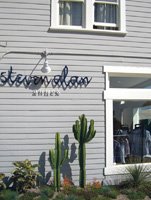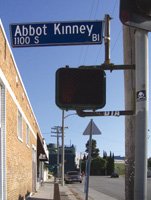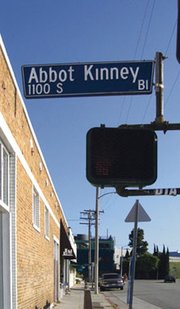Abbot Kinney Facing Change With Designer Stores
When the established New York design house of Steven Alan opened a boutique recently on the historically bohemian Abbot Kinney Boulevard, many started to wonder whether this unique street, which hosts independent booksellers and a medical-marijuana dispensary, was going corporate.
While there is no Gap store in this Venice neighborhood, a suburb of Los Angeles, people are getting nervous. One week before the Steven Alan Annex store opened at 1601 Abbot Kinney Blvd., independent retail pioneer Claudia Milan sold her self-named store at 1350 Abbot Kinney Blvd. to Los Angeles–based jewelry company Kamofie & Co.
Milan believes the increasing success of the street and its growing profile in the fashion crowd might make the thoroughfare lose its eclectic and unique character.
“It’s going to be a high-end designer road,” Milan said of the place where she sold women’s casual and designer clothes for the past six years. She will be moving her store to the wealthy seaside enclave of Manhattan Beach, Calif., this fall.
Her former neighbors left behind fear that one day Abbot Kinney will be packed with chain stores and restaurants, with no room left for independent businesses.
Signs of that were seen last year when a Pinkberry frozen-dessert shop opened at 1410 Abbot Kinney Blvd. Venice Unchained, a residents’ group, organized a petition drive to keep the Pinkberry store from moving in.
Their protests are making the rounds through Los Angeles City Hall, with city planners researching possible guidelines and restrictions on what kind of retail should populate the eclectic boulevard.
City Councilmember Bill Rosendahl, whose district includes Abbot Kinney, said some kind of guidelines could be coming out in 2009, but more public meetings on possible retail restrictions would be held. “We’re in a huge public discussion,” Rosendahl said. “But the street will continue to thrive and sell quality products.”
Retail evolution
No matter what kind of guidelines are forthcoming, change on Abbot Kinney is inevitable, said Rafael Padilla, the co-owner of Santa Monica, Calif.–based Par Commercial Realty.
Padilla grew up around the Abbot Kinney neighborhood. In the 1970s, it was a run-down place filled with second-hand shops. However, the success of the past five years has changed the place. “It went from Chevys to BMWs,” Padilla said.
He believes rents will increase and some of the street’s first wave of retailers will move out and make way for more high-profile retailers.
Local real estate brokers said retail rents for Abbot Kinney space are about$4.50 to $6 per square foot, which is still considered affordable when compared with surrounding areas.
Rents on Main Street in nearby Santa Monica are from $5 to $5.25 a square foot. Rents on the premier retail strip of Robertson Boulevard in Los Angeles are three times that much.
Change is already occurring. More than five buildings are for sale on Abbot Kinney Boulevard, said Valerie Schumann, a commercial broker with Bulldog Realty in Venice. But Schumann forecasted that the independent character of the street would remain. “There is more retail on the street but none of what we call ’formula retail,’” she said.
The real estate agent believes that Steven Alan’s status as an independent fashion label puts it in a different category from chain retailers despite the designer opening three West Los Angeles stores in the past two months.
Michael Paradise, the owner of The Stronghold, a branded store for a premium-denim label of the same name, believes the future of the street will include more boutiques owned by independent, if not established, designers such as Steven Alan. That’s because the street’s old buildings and art-inspired culture are attractive to designers and manufacturers who want to be noticed by the hip crowd that dines, shops and parties in Abbot Kinney.
“It’s bohemian. It has the ocean. Where can you go for that anymore?” Paradise said.
Eric Hartnack, the co-owner of the independent fashion brand Topo Ranch, runs a boutique at 1219 Abbot Kinney Blvd. and foresees the street as a collection of boutiques for more-established designers, but it will also have room enough for independent retailers and new labels like his.
“We wouldn’t be doing this [boutique] if it was not profitable for us,” Hartnack noted.
Store sales, he noted, increased 40 percent in May compared with the same time last year. Weekend foot traffic is strong and features many tourists. And people from surrounding areas such as Marina Del Rey and Pacific Palisades also patronize the area, Hartnack said.
No matter what future awaits the street, it is a different place from the blocks of artist live/work spaces encountered by retailer Claudia Milan when she moved there in 2000. “I thought it was a quaint neighborhood,” she said. “I thought it would be a great place for a boutique.”


























